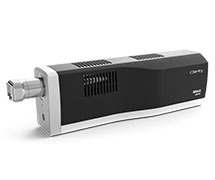
Clarity EBSD Detector Series
The world’s first and only commercially available Electron Backscatter Diffraction (EBSD) detector with unparalleled performance as low as 3 kV. This direct detection system is ideal for beam-sensitive perovskite, ceramic, or semiconductor materials that are difficult to analyze using conventional EBSD systems.

This revolutionary series utilizes single-electron detection to provide the high-fidelity EBSD pattern quality and unparalleled sensitivity that you expect to move your research forward.
- Clarity Plus – Efficient collection down to ~ 7 kV
- Clarity Super – Optimized for high performance down to 3 kV
Clarity uses a groundbreaking hybrid-pixel direct detection technology, with single-electron detection sensitivity. The incident electrons generate several electron-hole pairs within the silicon upon impact, and a bias voltage moves the charge toward the underlying CMOS detector, where it counts each event. This method is so sensitive that it can detect individual electrons not seen on conventional EBSD detectors that use phosphor screens or light transfer systems.

EBSD image quality and IPF orientation map from beam-sensitive MAPI perovskites collected a 10 kV, 150 pA beam dose.
Coupled with zero read noise, the Clarity provides unprecedented sensitivity and image quality performance. It can successfully detect and analyze patterns comprised of less than 10 e-/pixel. This makes the Clarity ideal for beam-sensitive samples and low beam-dose applications like hybrid organic-inorganic perovskite solar cells and ceramics. Additionally, the Clarity Super is optimized for lower kV acquisition, to improve the spatial resolution for fine-grained materials.

Features and Benefits
Beam Sensitive Materials Analysis
- Reveals never-before-seen structures by using low beam currents and energies to prevent damage
- Eliminates the need for conductive coatings or low-vacuum SEM settings to assess non-conductive materials like ceramics that charge under typical beam currents
- At low beam currents, obtains high-quality EBSD patterns and maps for investigating the effects of grain boundaries, grain size, and crystal orientation

EBSD Image Quality and IPF orientation map from cryo-forged nanotwinned titanium collected at 7 kV and 200 pA beam dose for improved spatial resolution.
Traditional Materials
- Uses high-dynamic-range imaging to ensure excellent EBSD pattern quality
- Enables the collection of extremely sharp EBSD patterns without using phosphor or optical lenses
- Improves spatial resolution at lower acceleration voltages
Conclusion
The Clarity EBSD Detector Series provides unparalleled sensitivity and pattern quality for EBSD pattern collection and mapping. It enables the analysis of beam-sensitive materials and provides quantified information about electron intensities across the broadest range of beam energies.

High-quality EBSD patterns collected with Clarity from a) silicon, b) olivine, and c) quartz.
